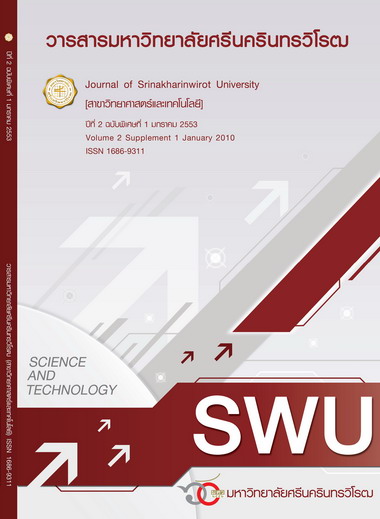การศึกษาการทำความเย็นด้วยคลื่นเสียง (STUDY OF SOUND WAVE COOLING)
Keywords:
Thermoacoustic, Refrigerator, Sound waveAbstract
บทคัดย่อ งานวิจัยเชิงการทดลองนี้มีวัตถุประสงค์เพื่อศึกษาหลักการทำความเย็นแบบเทอร์โมอะคูสติกโดยอาศัยแรงดันอากาศแบบคลื่นเสียงทำให้เกิดการสั่นพ้องในหลอดเสียงแบบคลื่นนิ่ง ปรากฎการณ์เทอร์โมอะคูสติกเกิดขึ้นเมื่อเกิดการสั่นพร้องในท่อเสียง ทำให้เกิดการถ่ายเทความร้อนอย่างต่อเนื่องระหว่างปลายทั้งสองข้างของรีเจนเนอเรเตอร์ ชุดทดลองที่สร้างขึ้นประกอบด้วย แหล่งกำเนิดคลื่นเสียง ท่อเสียงรีเจนเนอเรเตอร์ อุปกรณ์แลกเปลี่ยนความร้อนและสารตัวกลางในท่อเสียง คือ อากาศ ผลจากการศึกษาพบว่าความถี่ของคลื่นเสียงรูปไซน์ที่ป้อนให้กับแหล่งกำเนิดเสียง (ลำโพง) ขนาด 145 เฮิรตซ์ มีกำลัง 6.25 วัตต์ สามารถสร้างสภาวะคลื่นนิ่งภายในท่อเสียงของชุดทดลองได้ และมีอุณหภูมิแตกต่างระหว่างด้านร้อนกับด้านเย็นถึง 4 องศาเซลเซียส ที่สภาวะการเกิดคลื่นนิ่งวัดความดันอากาศภายใน Compliance volume (PH) และภายนอก Compliance volume (P1) พบว่าอัตราส่วน PH/P1 มีขนาดเพิ่มสูงขึ้นประมาณ 3 เท่า และความดันอากาศมีเฟสต่างกันประมาณ 90 องศา
Abstract
This study focused on the experiment of thermoacoustic refrigerator that used a sound pressure wave to produce the air oscillating as a standing wave in resonator tube. A thermoacoustic phenomenon appears when there is fluid oscillating as a standing as a standing wave. This oscillation results continuous heat transfer between two end of the regenerator. A thermoacoustic demonstration device constructed in this study consists of acoustic driver, reasonable tube, resonator and heat exchangers. The experimental results showed that the frequency of 145 Hz and 6.25 W of power can produce a standing wave in the resonator tube, and the temperature difference between the hot side and cold side was 4oC. On stage of the standing wave, the amplitude of pressure wave inside of the compliance volume (PH) is greater than the pressure outside (P1) of the resonator about 3 times. The phase of the pressure inside the compliance volume lags the phase of the pressure outside by 90oC at resonance.
Downloads
Downloads
Published
How to Cite
Issue
Section
License
Srinakharinwirot University Journal of Sciences and Technology is licensed Under a Creative Commons Attribution-NonCommercial-NoDerivs 4.0 International (CC-BY-NC-ND 4.0) License, Unless Otherwise Stated. Please Read Journal Policies Page for More Information on Open Access, Copyright and Permissions.



